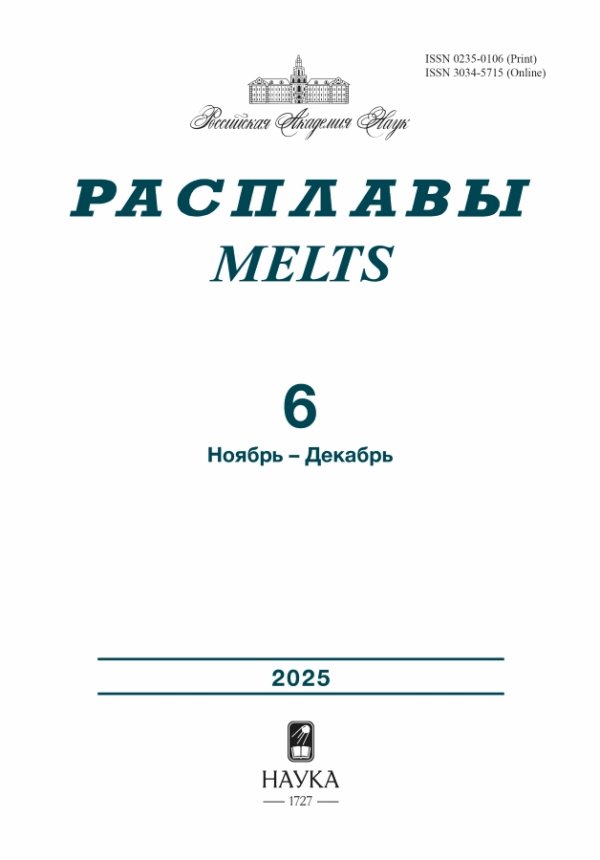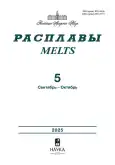Электронные спектры поглощения насыщенных растворов хлора в расплавленных хлоридах щелочных металлов в зависимости от температуры
- Авторы: Колобов А.Ю.1,2, Потапов А.М.2, Хохлов В.А.2
-
Учреждения:
- АО «ДИНУР»
- ФГБУН Институт высокотемпературной электрохимии
- Выпуск: № 5 (2025)
- Страницы: 455-466
- Раздел: Статьи
- URL: https://bakhtiniada.ru/0235-0106/article/view/309551
- DOI: https://doi.org/10.31857/S0235010625050045
- ID: 309551
Цитировать
Аннотация
Зарегистрированы электронные спектры поглощения насыщенных растворов хлора в расплавленных хлоридах щелочных металлов в интервале от температуры плавления соли до 1000°С. Для регистрации спектров использовали спектрофотометр СФ-26, переоборудованный для высокотемпературных измерений. Осветитель был отделен от основного корпуса и между осветителем и монохроматором была помещена силитовая высокотемпературная печь с окнами. Для проведения экспериментов были использованы кварцевые оптические ячейки с толщинами поглощающего слоя 0.8, 1.0 и 1.5 мм. Самая тонкая кювета (0.8 мм) была использована для регистрации спектра растворенного хлора в расплавленном хлориде цезия, так как растворимость хлора в нем максимальна и, соответственно, оптическая плотность такого расплава тоже максимальна. Найдено, что во всех солях спектр поглощения состоит из единственной широкой полосы поглощения с максимумом в районе 26000–28000 см-1. В диапазоне 13000–8000 см-1поглощение практически отсутствует. С повышением температуры, а также при переходе от хлорида натрия к хлориду цезию, максимум поглощения сдвигается в область меньших энергий. Растворимость хлора в расплавленных солях увеличивается с повышением температуры, что указывает на эндотермичность процесса растворения. По величинам растворимости были рассчитаны термодинамические характеристики этого процесса. Для процесса растворения Cl2в расплавленных хлоридах щелочных металлов характерно положительное изменение энтропии и энтальпии. Это указывает на растворение хлора не в виде простых молекул Cl2, а скорее на образование их ассоциатов с ионами солевой среды. При повышении температуры и переходе в ряду солей-растворителей от NaCl к CsCl изменение энергии Гиббса смещается в сторону меньших (более отрицательных) значений, что соответствует увеличению растворимости хлора в том же направлении. И в этом же направлении увеличивается как физическая, так и химическая (образование ионов) составляющие общей растворимости газа. Сделан вывод о преобладающем химическом механизме растворения хлора в расплавленных хлоридах щелочных металлов.
Ключевые слова
Об авторах
А. Ю. Колобов
АО «ДИНУР»; ФГБУН Институт высокотемпературной электрохимии
Email: art.kolobov@yandex.ru
город Первоуральск, Свердловская область; г. Екатеринбург
А. М. Потапов
ФГБУН Институт высокотемпературной электрохимии
Email: art.kolobov@yandex.ru
г. Екатеринбург
В. А. Хохлов
ФГБУН Институт высокотемпературной электрохимии
Автор, ответственный за переписку.
Email: art.kolobov@yandex.ru
г. Екатеринбург
Список литературы
- Колобов А.Ю., Потапов А.М., Хохлов В.А. Получение разбавленных растворов трихлоридов редкоземельных металлов хлорированием их оксидов в расплавленной эквимольной смеси NaCl-KCl // Расплавы. 2024. № 6. С. 663–675.
- Колобов А.Ю., Потапов А.М., Хохлов В.А. Получение разбавленных растворов хлоридов лантана (III) и неодима (III) в расплавленной эквимолярной смеси NaCl-KCl // Труды Кольского научного центра РАН. Серия: Технические науки. 2024. Т. 15, № 1. С. 249–254.
- Волкович B.А., Медведев Е.О., Васин Б.Д. и др. Спектроскопическое исследование процессов хлорирования оксидов лантаноидов в расплавах хлоридов щелочных металлов // Расплавы. 2006. №. 5. С. 21–28.
- Морозов И.C. Применение хлора в металлургии редких и цветных металлов.M.:Наука, 1966, 254 c.
- Chen Y. et al. Hot chlorination corrosion of metallic nickel by chlorine catalyzed by sodium chloride // ACS omega.2020. Т. 5. №. 42. С. 27278–27286.
- Волков С.В., Наумов В.С. Спектроскопическое исследование расплавов хлоридов щелочных металлов с нестехиометрическим содержанием хлора // Укр. хим. журн.1979.Т. 45. № 12. С. 1143–1148.
- Greenberg J., Sundheim B.R. Absorption Spectra in Molten Salt Solutions // Phys. Chem. 1958. V.29.№ 5. P. 1029–1032.
- Andresen R.E., Ostvold T., Oye H.A. // Proc. Int. Symp. on Molten Salts. Ed. by J. Paul Pemsler. 1976. Pp. 111–122.
- Хохряков А.А., Михалева М.В., Молчанов А.М. Электронные спектры поглощения растворов молекулярного хлора в расплавленных хлоридах щелочных металлов // Журнал неорганической химии. 2007. Т. 52. № 10. С. 1705–1708.
- Лошагин А.В. Электронные спектры поглощения ионов титана, платины и иридия в среде расплавленных хлоридов щелочных металлов. Автореф. дис... канд. хим. наук, Свердловск. 1981. 16 с.
- Бабко А.К., Пилипенко А.Т. Фотометрический анализ. М.: Химия. 1968. 387c.
- Смирнов М.В., Комаров В.Е., Насонов Ю.В. Растворимость хлора в расплавленных бинарных смесях хлоридов щелочных металлов и хлористого бария // Труды института электрохимии УНЦ АН СССР. 1971. Вып. 17. С. 45–48.
- Смирнов М.В., Комаров В.Е., Насонов Ю.В. Растворимость хлора в расплавленном хлористом лантане и его смесях с хлоридами щелочных металлов и хлористого бария // Труды института электрохимии УНЦ АН СССР. 1971. Вып.19. С. 9–12.
- Мужжавлев К.Д., Лебедев О.А., Татакин А.Н., Дроняева О.Н. Растворимость хлора в расплавленных хлоридных электролитах // Цветные Металлы. 1970. № 10. С. 46–51.
- Смирнов М.В., Комаров В.Е., Насонов Ю.В. О механизме растворения хлора в индивидуальных расплавленных хлоридах щелочных металлов и их смесях. Свердловск. 1969. 7 с., деп. в ВИНИТИ 17.06.69, № 826–69.
- Укше Е.А., Леонова Л.С., Букун Н.Г. Газы в расплавленных солях // Ионные расплавы. Киев: Наук. Думка. 1974. Вып.1. С. 21–42.
- Рябухин Ю.М., Леонова Л.С. Растворимость хлора в расплавленном хлористом свинце // Журнал неорганической химии. 1968. Т. 13. № 9. С. 2621.
- Рябухин Ю.М., Букун Н.Г. Механизм растворения хлора в расплавленных хлоридах щелочных металлов // Журнал неорганической химии. 1968. Т. 13. № 4. С. 1141–1145.
- Рябухин Ю.М. Растворимость хлора в расплавленных хлоридах // Журнал неорганической химии. 1962. Т. 7. № 5. С. 1101–1104.
- Некрасов В.Н. Физическая химия растворов галогенов в галогенидных расплавах. М.: Наука. 1992. 216 с.
- Леонова Л.С., Рябухин Ю.М., Укше Е.А. Растворимость и диффузия хлора в расплавах бинарной системы KCl-NaCl // Электрохимия. 1969. Т. 5. № 4. С. 464–466.
- Рябухин Ю.М. Растворимость хлора в эквимолекулярной смеси хлоридов натрия и калия // Журнал неорганической химии. 1966. Т. 11.№ 10. С. 2415–2417.
- Укше Е.А., Леонова Л.C., Явонова Г.Н., БукунH.Г. Влияние комплексообразования на растворимость и диффузию молекулярного хлора в ионных жидкостях // Электрохимия. 1971. Т. 7. № 3. С. 390–393.
- Леонова Л.С., Укше Е.А. Растворимость и коэффициенты диффузии хлора в расплавахRbCl // Электрохимия. 1970. Т. 6.№ 6. С. 892–893.
- Kolobov A., Khokhlov V., Potapov A., Kochedykov V. Chlorine solutions in molten alkali chlorides // Zeitschrift fur Naturforschung. Section A: Journal of Physical Sciences. 2007. V.62.№ 3–4.Pp. 205–212.
- Байбаков Д.П. Исследование кинетики и механизма процесса абсорбции хлора расплавами хлористых солей. Дис. канд. тех. наук. ЛТИ им. Ленсовета. Ленинград. 1971. 144 с.
Дополнительные файлы









